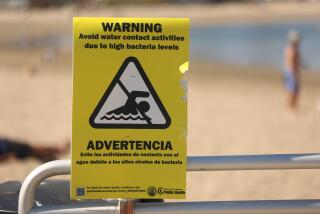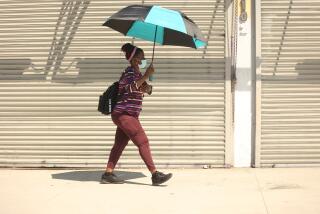More than 1,000 dead fish at Malibu Lagoon may be tied to record-warm ocean temperatures

Craig Sap, superintendent of California State Parks’ Angeles District, talks about the fish die-off in Malibu Lagoon.
Authorities made the grim discovery last week: More than 1,000 dead fish floating at Malibu Lagoon.
California State Parks scientists are running tests to determine the cause, but officials suspect higher-than-normal water temperatures played a role.
The die-off comes amid a summer of extreme heat across California that has included record ocean temperatures from San Diego to Los Angeles and beyond.
Warming water temperatures can alter the marine food chain in various ways — bringing about toxic algae that make crabs, for example, dangerous to eat. Researchers are also seeing more warm water animals, such as jellyfish and stingrays, off the coast.
Craig Sap, superintendent of California State Parks’ Angeles District, said Monday that it could take several days to confirm what led to the death of about 1,500 mullet and topsmelt fish that were discovered floating in the lagoon Thursday morning.
Officials said oxygen levels in the water tested normal, but the temperature in the lagoon was “significantly elevated” — about 82 degrees. Relentless summer heat and a lack of fog along the coast could have caused the temperature of the water to soar, Sap said.
“That temperature is probably beyond their tolerance level,” he said of the fish.
Although die-offs aren’t uncommon in lagoon environments, Sap said this was the largest he could recall in Malibu.
Upticks in ocean temperatures are normal in summer months, but what has been unusual is the level and spread of the increasing temperatures, said National Weather Service meteorologist Todd Hall.
This time of year, water around the Santa Monica Pier would normally be about 68 degrees. Monday afternoon, the temperature was 72 degrees. At Scripps Pier in La Jolla, temperatures are also typically about 68 degrees. Monday, the temperature was 77 degrees. Earlier this summer, that pier recorded its warmest water temperature reading in a century.
On average, waters have been about 5 degrees warmer than normal, and that’s throughout coastal waters of Southern California, Hall said.
It’s been that way for about two years, he said, because of a lack of coastal winds from April to June. Ocean water temperatures tend to lag behind land temperatures by a few months.
“We haven’t had quite as much wind along the Southern California coast the last couple years to help bring the cooler water up to the surface. It’s just a weather pattern we’ve been in,” Hall said.
California’s summer has been marked by scorching temperatures that have sparked destructive wildfires, which many experts see as a sign of climate change. Hall said the hotter conditions play a factor in the warming ocean, but it’s complicated.
“The bottom line is that, without a doubt, the Earth has been warming since the late ’70s. That’s not up for debate because we have a satellite that’s measuring the temperature of the Earth,” he said. “So climate change is involved in this, but there’s also other factors.”
For instance, strong El Nino events in the late 1990s and again a couple years ago might still be contributing to warm Southern California coasts now. Meteorologists are also monitoring a possible El Nino developing in Southeast Asia and moving toward North and South America, which brings warmer waters and, often, different species of fish to the coast.
“Is this a precursor of that? That’s what we’re trying to figure out,” Hall said.
But it’s not unusual to see different species inhabit shallow waters in the summer months.
“I grew up in San Diego, [and] I remember as a child there and throughout my time as a meteorologist, we occasionally get these jellyfish and stingrays in August,” he said.
Despite the concerning increase in ocean temperatures, the waters aren’t warming everywhere. In Los Angeles Harbor, temperatures are at an expected 68 degrees, and off Zuma Beach, waters are at 67 degrees, just one degree higher than normal.
“It depends on the winds that are occurring, it depends on whether the clouds went away quicker today than they did yesterday … what kind of swells, bigger waves or smaller waves,” Hall said.
California State Parks crews on Monday wore masks as they bagged the dead fish that had collected along the rim of the lagoon. About 85% of the fish found floating belly-up were mullet.
“The smell now that we’re moving them is pretty odoriferous,” Sap said. The carcasses were to be taken to a landfill.
Malibu Lagoon underwent a hotly debated $7-million restoration that wrapped up in 2013.
State officials and other proponents of the project said at the time that the lagoon was degraded and suffering from low oxygen levels, tainted sediment and poor water quality that harmed fish and other wildlife. Opponents contended that the lagoon was a functioning ecosystem and that the project was unnecessary.
Twitter: @Hannahnfry
alejandra.reyesvelarde@latimes.com
UPDATES:
7:05 p.m.: This article was updated with additional information about the possible causes of the fish die off.
This article was originally published at 3:50 p.m.
More to Read
Sign up for Essential California
The most important California stories and recommendations in your inbox every morning.
You may occasionally receive promotional content from the Los Angeles Times.












